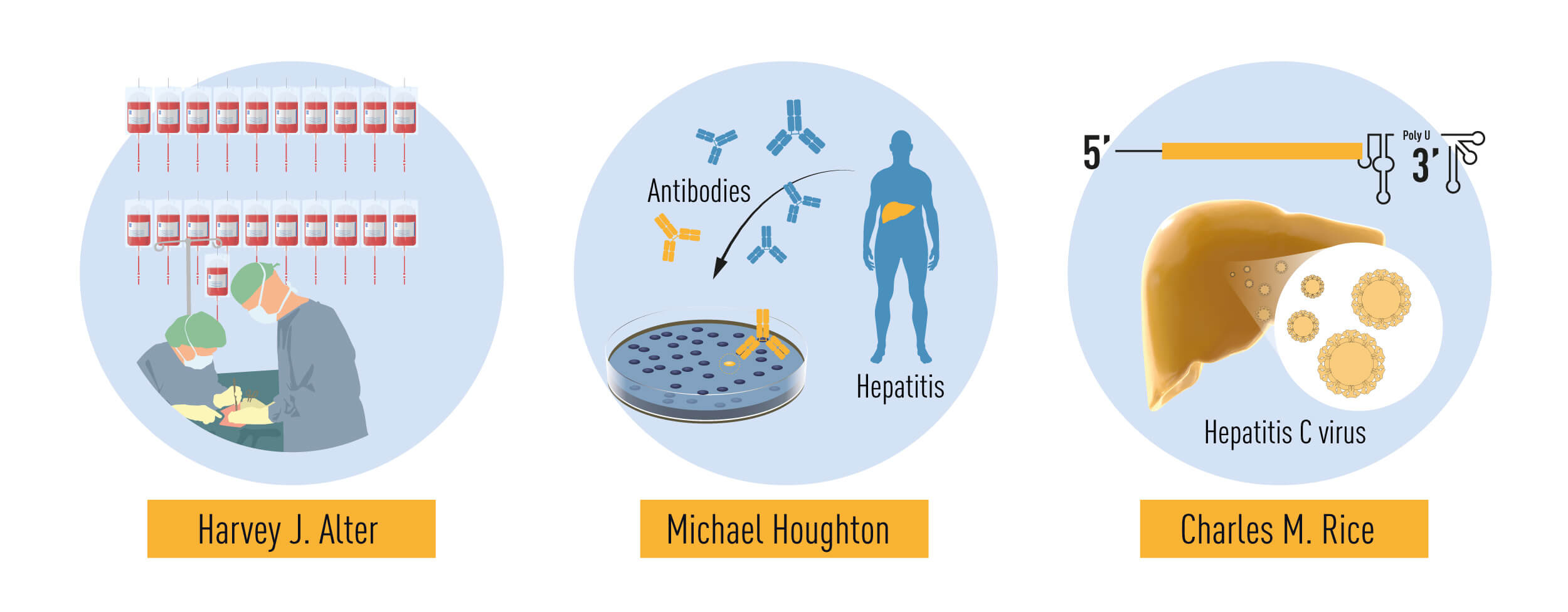Hepatitis C Virus Discoverers Win 2020 Nobel Prize in Medicine
By Rajaneesh K. Gopinath, Ph.D.
The Nobel Prize in Physiology or Medicine for the year 2020 was jointly awarded to Harvey J. Alter of the National Institutes of Health, Michael Houghton of the University of Alberta, and Charles M. Rice of Rockefeller University for their seminal discovery of the Hepatitis C Virus.
The trio was awarded for “a landmark achievement in our ongoing battle against viral infections,” announced the Nobel Assembly at the Karolinska Institutet on October 5th in Stockholm, Sweden. The discovery “made a decisive contribution to the fight against blood-borne hepatitis, a major global health problem that causes cirrhosis and liver cancer in people around the world.”
Hepatitis is a liver inflammation majorly caused by viral infections. There are two main forms of hepatitis; one caused by the Hepatitis A virus, which gets transmitted by contaminated water or food, and the other caused by the Hepatitis B virus or Hepatitis C virus that is blood-borne. While the former is an acute disease, the latter is a chronic disease that may progress to cirrhosis and hepatocellular carcinoma. In 1967, Baruch Blumberg discovered the Hepatitis B virus for which he won the Nobel Prize in Physiology or Medicine in 1976. The discovery led to the development of blood tests and the first Hepatitis B vaccine in 1969.
Harvey J. Alter, who was studying the occurrence of hepatitis in patients receiving blood transfusions, was perplexed why a large number of cases were unexplained even after eliminating the ones caused by Hepatitis A or B viruses. Alter’s research helped define a new, distinct form of chronic viral hepatitis, classified as “non-A, non-B” hepatitis (NANBH). He and his colleagues demonstrated that the blood from these patients could transmit the disease to chimpanzees.
However, the causative virus remained unidentified until Michael Houghton attempted to isolate the genetic sequence. Between 1982 to 1989, he conducted several challenging investigations along with his colleagues Qui-Lim Choo and George Kuo from the pharmaceutical firm Chiron Corporation, firmly aided by the biological samples (from the NANBH chimpanzee model) provided by Daniel W. Bradley from the Centers for Disease Control and Prevention (CDC). They created a collection of DNA fragments from nucleic acids found in the Chimpanzee blood and screened tens of millions of bacterial cDNA clones derived from them. In an era when the PCR technology was still not developed, this task was arduous and not met with immediate success.
Eventually, following inputs from Dr. Kuo, Houghton undertook a novel approach where he initiated a blind cDNA immunoscreening. By using the sera from NANBH patients as a presumptive source of viral antibodies, he conducted a large-scale screening of bacterial proteomic cDNA libraries derived from NANBH-infectious chimpanzees. This led to the isolation of a single small cDNA clone derived from a novel RNA virus belonging to the Flavivirus family. The causative agent was named Hepatitis C virus.
The only thing that remained was to prove that the Hepatitis C virus alone could cause chronic hepatitis. Charles M. Rice, who was then a researcher at Washington University in St. Louis, provided the final clue by identifying a previously uncharacterized region that turned out to be responsible for virus replication. Using genetic engineering, he generated an RNA variant of the Hepatitis C virus that included the newly defined region and injected them into the liver of chimpanzees. This proved that the virus alone could cause the disease.
Although a Hepatitis C vaccine is still elusive, this seminal discovery has led to the development of highly sensitive blood tests and potent antiviral drugs capable of curing the disease. With global efforts, the eradication of this virus is an achievable dream.
 Illustration: © The Nobel Committee for Physiology or Medicine. Illustrator: Mattias Karlén
Illustration: © The Nobel Committee for Physiology or Medicine. Illustrator: Mattias Karlén
Summary of the discoveries awarded by this year’s Nobel prize. The methodical studies of transfusion-associated hepatitis by Harvey J. Alter demonstrated that an unknown virus was a common cause of chronic hepatitis. Michael Houghton used an untested strategy to isolate the genome of the new virus that was named the Hepatitis C virus. Charles M. Rice provided the final evidence showing that the Hepatitis C virus alone could cause hepatitis.
The prestigious award comes with a gold medal and prize money of 10 million Swedish kronor (over US$ 1,118,000).
References
- https://www.nobelprize.org/prizes/medicine/2020/press-release/
- https://www.journal-of-hepatology.eu/article/S0168-8278(09)00535-2/fulltext
©www.geneonline.com All rights reserved. Collaborate with us: service@geneonlineasia.com









